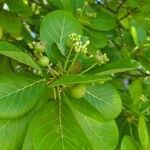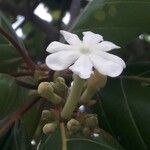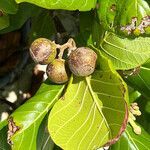Small trees, 3-8 m tall; bark becoming black, smooth or often lenticellate; branchlets rather stout, densely strigillose to velutinous-tomentulose usually becoming glabrescent. Petiole stout, 1.5-5 cm, densely strigillose or velutinous; leaf blade drying thinly to stiffly papery, broadly obovate or broadly elliptic, 11-20 × 8-18 cm, adaxially glabrescent, usually shiny, and often rugulose, abaxially densely tomentulose or strigillose to glabrescent, base obtuse, rounded, subcordate, or shortly cordate, apex obtuse or rounded sometimes with a short tip 3-5 mm; secondary veins 7-11 pairs, weakly but regularly looping to connect; stipules ovate or lanceolate, 6-11 mm, moderately to densely strigillose to strigose sometimes becoming glabrescent, obtuse to rounded. Inflorescences produced in with or often below leaves, subcapitate to congested-cymose, densely velutinous-tomentulose; peduncles 3-12 cm; branched portion 1.5-3 × 2-3.5 cm, axes scorpioid; bracts ovate, 5-7 mm, caducous. Flowers sessile. Calyx densely velutinous-tomentulose to strigillose; ovary portion obconic to cupulate, 2-2.5 mm; limb tubular, 2-3.5 mm, truncate. Corolla white, outside densely velutinous-tomentulose to strigillose; tube 2.5-3 cm, inside glabrous except sericeous in throat; lobes 7 or 8, obovate, 8-10 mm, obtuse to rounded. Drupes apparently green at maturity, oblate, 2-3 cm in diam., sparsely strigillose or tomentulose to eventually glabrescent; pyrene included in fibrous mesocarp. Fl. Apr-Jul.
Leaves crowded at the ends of the twigs; blades 5–32 × 3.5–22.2 cm, obovate, rounded to obtuse at the apex, rounded to cordate at the base, glabrous or almost so above, glabrous to velvety pubescent beneath; petioles 0.5–3(12) cm long; stipules free but overlapping the terminal bud, 0.7–2.3 cm long, broadly elliptic, soon falling.
A shrub or small tree. It grows 6 m tall. It spreads 1-3 m wide. The bark is smooth and creamy grey. The leaves are large and green and have prominent veins. The leaves are 15-23 cm long by 10-18 cm wide. There are fine hairs under the leaves. The flowers are white and have a scent. They open at night for one night.
Ovary 4–9-locular; style slender, 1.8–4.5 cm long; stigma green, obconic-cylindric, grooved, slightly bifid, reaching to or just beyond the anthers in long-styled flowers and to less than a half the way up the tube in short-styled flowers.
Flowers fragrant, in cymose pubescent to glabrous inflorescences from the upper axils; peduncles 0.4–19 cm long, reddish at the apex; secondary peduncles absent or 0.3–3 cm long; pedicels mostly absent or very short.
Corolla white, cream-coloured or yellowish or greenish-white, sometimes slightly pink-tinged, appressed silky pubescent outside; tube 2–4.6 cm long, narrowly cylindrical; lobes 4–9(11), 2–15 × 1.5–8(10) mm, oblong.
Calyx tube green, tinged pink, 1–3(5) mm long, campanulate, appressed pubescent; limb yellowish, 2–5 mm long, undulate or with lobes 0.2 mm long.
Stems stout, with obvious leaf scars, lenticellate, bark brown, slightly rough, pubescent, at length glabrescent; young shoots velvety tomentose.
Anthers the same number as the corolla lobes, 3–5 mm long, linear, subsessile in the throat, included.
Shrub or small, branched or unbranched tree 1–8(18) m tall with trunk up to 15 cm in diameter.
Fruit green, streaked brownish-red, 0.8–2.5 × 1.2–3.5(4) cm, ovoid or subglobose, woody.
Seeds 2–5 × 1.5–5 mm.
Pending.










